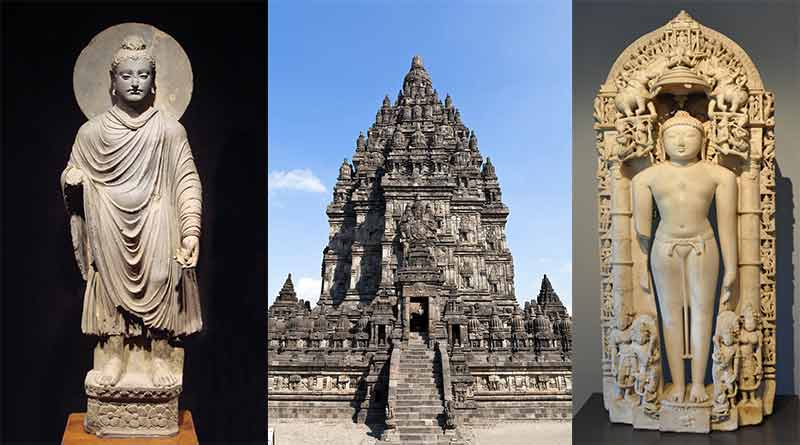Religious Movement of Ancient India

A religious movement raised in India in 600 BC, which agitated Indian public intellectually. 6th century BC Is considered to be the age of intellectual contemplation. At this time there were thinkers like Buddha and Mahaveer in India. At the same time there was an atmosphere of religious movement in the world. Pythagoras in Greece, Jatathrusht in Iran, Confucius and Laotse in China
In this period, traditional temporal religion was going at its own pace. In this, Indra Devata was considered as the head. He was called Shakra and Madhva. Brahma (Bamma) is also mentioned in Buddhist texts.
Rudra was considered as Shiva.
Paninee has discussed Vasudev sect, which was associated with Bhagavat religion. The Mahabharata also mentions Krishna worship.
Jain texts mention Skanda, who was the son of Shiva. Snake worship was also done in this era. The worship of Yaksha is also mentioned in Buddhist and Jainism texts.
In the 6th century BC the life of Eastern Uttar Pradesh and Bihar (Gangey Pradesh of North India), socially and economically urbanization, expansion of craft community, and rapid growth in trade and commerce, were closely related to changes in the then religion and philosophical contemplation.
The conflicts between traditional orthodox and aspirations of new emerging classes in the cities made the process progressive and such a new power and modern prosperity emerged in the field of its contemplation which not only affected India but also a large population.
Magadh was the center of this intellectual activity. The foundation of a huge empire was also falling in Magadh in this period.
There were many direct and indirect reasons for this movement which can be seen in the then social, religious and economic changes. The mutual struggle can be visualized at Social level among Arya–Anarya, Brahmin–Kshatriya, traditional Varna system, and different castes.
The Vedic religion was absolutely trendy, Vedic Aryans always wished for best wealth and opulence.. The protest against this ideology is seen in an enlightened class of society since the Rig Vedic era.
Before the rise of Jainism and Buddhism, there were many differences emerging. But this era is mainly seen full of Nivratti Margee ideology. There have been social, political, economic changes in this era. Where some people have adopted Nivratti Margi religion by instinctual spiritual inspiration, some other people adopted it to get rid of social inferiority, economic difficulties.
It was natural for those people to get involved in such religious movements who were struggling with difficult social and economic difficulties, which contained the measures of emancipation for these difficulties.
There were many thinkers in addition to Buddha and Mahaveer Swami in this era, who played an important role in this religious movement.
According to the Buddhist texts, there were 62 religious sects in existence in this period and according to Jain texts (Sutra Kritang), there were 363 total religious sects in this age.
Ajit Keshkambeelan-
He was the first Materialistic thinkers of India. He believed that there was no fruit of good and evil deeds and each event was in accordance with its nature. So do whatever you want. It is also called as an Wishful.
Charvak-
He was the exponents of Lokayaat philosophy.
Puran Kashyap-
He believed that there is neither karma nor rebirth. He had laid the foundation of philosophy. The soul is separate from the body. His sect had merged with the sect of Makkhali Goshaal.
Makkhali Goshaal-
He stayed with Mahaveer Swami for 6 years. Then founded the Aajeevak sect. He believed that the soul has to go through the predetermined Atal chakra of many rebirths and then in every birth it is related to the body. It has to happen, no matter how was his karmas. He was called Determinists. Bindusaar patronized this religion .Ashok and Dashrath gave him caves in charity.
Kaatyaayan-
It was also a determinists. Katyayan also did not believe in karma and rebirth. In his view, seven things – earth, water, air, happiness, sorrow, and creatures neither be created nor destroyed.
Sanjay velattaputt –
He is considered indecisive (अनिश्चयवादी ). He believed that “neither can it be said that there is heaven or hell” nor “both are not.”
Charvak-
He is considered as disciples of Brihaspati. He wrote Brihaspati Sutra (Granth). He was a materialistic philosopher. He believes that direct experience is the only means of knowledge.
Presumably in these extreme and socially devoid of thinking, the notion of the law of causal nature was working, from which the idea developed. There is always work and reason relation functioned in nature which neither God can change nor is it possible with rituals or sacrifices.
Today, all these contradictory religions are organized under the Hindu religion and are working together for the development of India.
Reference : https://www.indiaolddays.com/



